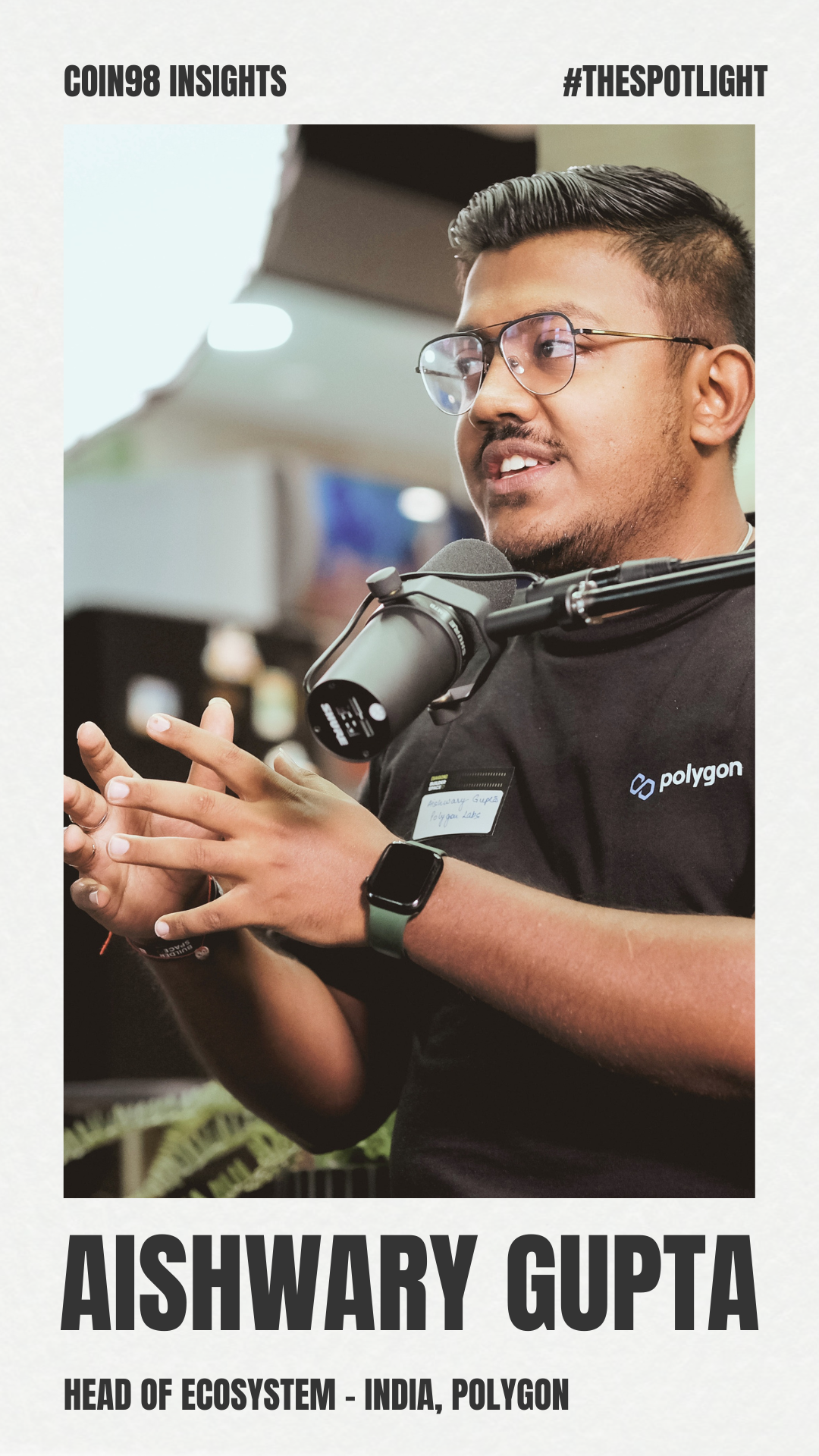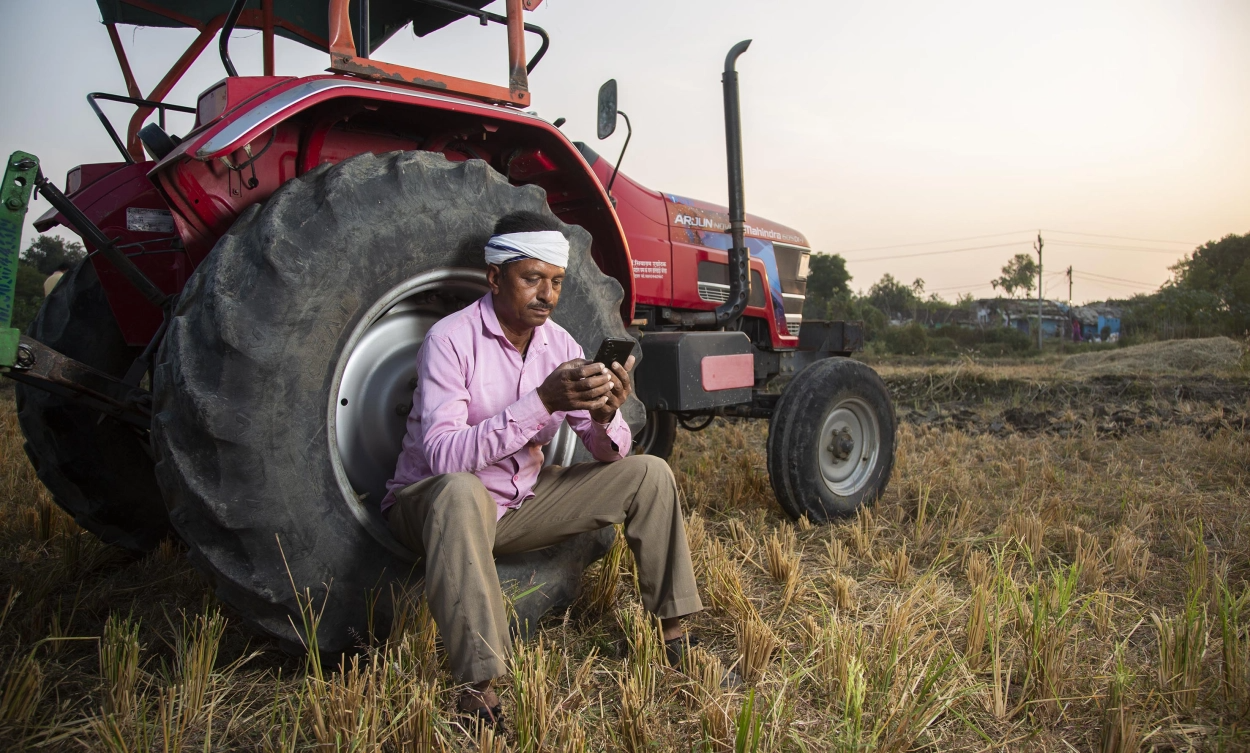Revolutionary Polygon 2.0: Total Makeover Ahead

On an early July day, Aishwary Gupta arrived at the Coin98 office. Wearing a backpack, a t-shirt, and jeans, with nimble steps, Aishwary gave the impression of being a "tech guy" focused on coding, rather than someone involved in finance.
Aishwary Gupta, born and raised in India, a hub of many technology talents, is currently the Head of Ecosystem India at Polygon. Before getting involved with crypto, he had worked at American Express and several FinTech companies.
The Spotlight is a series of conversations between Coin98 Insights and industry builders about hot topics in the market.
This is a highlight video, readers can see the full conversation in the article below.

- India is considered a country that produces many tech talents. According to a report by IAMAI and Kantar, India had 52% of the population or 759 million people accessing the internet at least once a month in 2022. I'm curious how Indians are approaching blockchain, and how blockchain will change their lives?
Aishwary Gupta: There are three main trends in terms of the impact of blockchain on people's lives in India.
The first trend relates to the 3% of the population that has access to various resources and services. For this group, the benefits of blockchain may not be as significant as they are already well-served.
The second trend covers around 20-25% of the population, with the presence of the Indian government and most domestic businesses. They have access to resources but have not fully utilized them.

During the COVID pandemic, blockchain has been used to generate verifiable COVID-validated certificates, eliminating the issue of fake certificates
Efforts have been made between blockchain companies and government during the COVID-19 pandemic to apply blockchain technology to address real-life issues. For example, blockchain has been used to create verifiable COVID-validated certificates, eliminating the problem of fake certificates.
Furthermore, blockchain solutions have been deployed to track the allocation and utilization of funds for maternity care centers. As a result, nearly 2.5 million pregnant women have been supported within six months.

There is a growing trend towards focusing on individuals with limited support and income, with the goal of bringing solutions from the state government down to the that level.
Thanks to these efforts, the Indian government is playing a significant role in promoting the application of blockchain technology
For instance, milk production is a major issue, as it is difficult to ascertain whether the milk comes from a specific farm or if any chemical additives have been used to produce artificial milk or something like that.
Therefore, there is a collaboration to deploy supply chain data on milk production using blockchain to demonstrate the authenticity of the product.
- Are financial institutions in India ready for blockchain technology?
Aishwary Gupta: I think there are two aspects to consider: one is the use of blockchain in the financial sector, and the other is in non-financial sectors.
In the financial sector, using cryptocurrency as a means of payment is not suitable, so financial organizations do not see a reason to adopt it.
However, India will host the G20 Summit this year. One of the key goals they want to address is international payments, at least among G20 member countries, to reduce costs and increase efficiency. I believe this is also a starting point for the application of blockchain technology in finance.
On the non-financial side, blockchain is becoming increasingly popular. One example is the e-commerce giant, Flipkart. With 450 million users, Flipkart is creating a Metaverse shopping experience with NFTs on the Polygon chain.
The application of blockchain in non-financial sectors is growing. However, in the financial sector, we are just beginning to address international payment issues
Looking beyond India, the interest of major financial institutions such as BlackRock in Bitcoin ETFs can be seen as a positive sign.
If Bitcoin ETFs are approved, financial organizations will have indirect access to Bitcoin, thus attracting new capital into the cryptocurrency ecosystem. I believe that the interest of large global financial institutions will have a positive impact on the market and provide more opportunities for investors.

- The market has seen significant negative changes since 2021, causing some users to leave crypto. However, Polygon remains a vibrant blockchain. In your opinion, what has contributed to Polygon's continued appeal?
Aishwary Gupta: At Polygon, we focus on supporting true builders and the projects they bring to the ecosystem.
There are many great projects in the market, but not everyone knows how to do marketing, as most of them are primarily focused on product development. If they come to Polygon, we will provide support.
Recently, we launched Polygon zkEVM and are bringing many DeFi applications to it. Instead of offering sponsorship packages worth hundreds of thousands of dollars, we have built a robust infrastructure system. You can collaborate with us, or you can collaborate with projects on Polygon. From there, you can easily extract value from the ecosystem.
We have recently partnered with brands from traditional markets such as Starbucks, Nike, and Swoosh. They may not understand Web3, but they understand Web2. We understand Web3, so we create win-win relationships.
They may not understand Web3, but they understand Web2. We understand Web3, so we create win-win relationships
Polygon is not just about pleasing partners; we meet their genuine needs and receive the desired value in return. We are honest in our collaborations to ensure that partners continue to stay with Polygon.
- Previously, Polygon launched Polygon zkEVM, now Polygon Labs develops the Polygon Validium network, running in parallel with Polygon zkEVM. Are there any conflicts of interest between these two networks?
Aishwary Gupta: It’s actually no because each network serves a different purpose, and that is how typical blockchains and two typical rollups like optimistic and zero-knowledge rollups are designed.
In an optimistic rollup, transactions are assumed to be correct without mathematical verification, but when moving back to L1, assets are locked for 7 days for transaction verification. I do not want my assets to be locked for 7 days; this is a major concern.
Meanwhile, in a zero-knowledge rollup, every transaction is verified through computation and on-chain storage. The verification workload increases, which means higher costs, but it also increases security. Therefore, we developed Polygon zkEVM for applications in the financial sector that require high security and on-chain storage.
As for the transition from PoS to Validium, we store data off-chain while computation is still performed on-chain. Validium is most effective when used for applications that do not require high security, such as gaming or NFTs. Thus, Validium is more suitable for non-financial use cases.
Consequently, Polygon zkEVM and Polygon Validium can operate simultaneously without any problems.
- Does Polygon have plans to develop any other network?
Aishwary Gupta: No. We already have Polygon zkEVM and Polygon Validium. In the future, we will transition the existing Supernet system to zk-SuperNet to address two important issues: liquidity and composability.
We are developing Polygon 2.0, which will transform Supernet into zk-SuperNet. We are currently testing the alpha version of this upgrade
The new infrastructure of Polygon 2.0 will connect to nearly 120 Supernets, making a total of 122 chains, including zkEVM and Polygon PoS.
If these chains do not find a way to communicate with each other and liquidity remains fragmented on each individual chain, Polygon will face a major issue of liquidity fragmentation.
We are working towards launching Polygon 2.0 to create a network that encompasses all liquidity and enables easy interaction between different chains.
- Polygon 2.0 will be complete by the end of 2024, what is the most difficult part of building this system that takes so long?
Aishwary Gupta: Since we are completely changing technology stack, time consuming is inevitable. We need to move from PoS to Validium and from Supernet to zk-SuperNet. At the same time, we need to ensure that liquidity is unified across this vast system. It can be considered a comprehensive overhaul.
Furthermore, we cannot rush the process as the network is currently operating with over 5 billion USD in value. We have to ensure proper checks, procedures, and thoroughness so our efforts do not go down the drain.
That is why we anticipate completing everything by 2024.

- If the Bull run comes in 2024, do you have any advices for the builders in the crypto market?
Aishwary Gupta: Haha... It is difficult to say whether there will be a bull run in 2024 or not, but there is still a lot of potential for builders in the crypto market.
We have successfully launched in Vietnam and are attracting many brands to participate in building applications in this space. I believe that the Web3 community in Vietnam is full of potential.

There are many dedicated developers in this country, making Vietnam as an attractive land of opportunities
Singapore also has many developers, but they choose to come to Vietnam because the costs are not too high, and the Web3 community in Vietnam is strong. There are many dedicated developers in this country. Vietnam is an attractive land of opportunity!
Other projects can look to platforms such as Coin98, which has a comprehensive ecosystem and even its own investment fund. If someone has a product, they can receive support from us as well as Coin98.
Therefore, before a bull run occurs, I advise these builders to focus all their efforts and diligently build their products. When the bull run comes, that will be the time to reap the rewards.
- What is your outlook on the future trends in the crypto industry? Which sector do you think will attract money when a Bull run comes?
Aishwary Gupta: I think there are three aspects that I am very bullish on. These are payment solutions, NFT use cases, and data ownership.
For me, international payments are the most intriguing aspect because they are being actively researched and invested in by many businesses.
With NFTs, I believe there is still a lot of scope for them to bring about more use cases, increase value, and become more widespread. We are only at the start of exploring the possibilities of NFTs.
Lastly, I have particular faith in the concept of data ownership. Platforms such as Lens enable users to own and control their data, creating opportunities for individuals to monetize their data in the manner of their choosing. Data ownership is an essential element for the future.